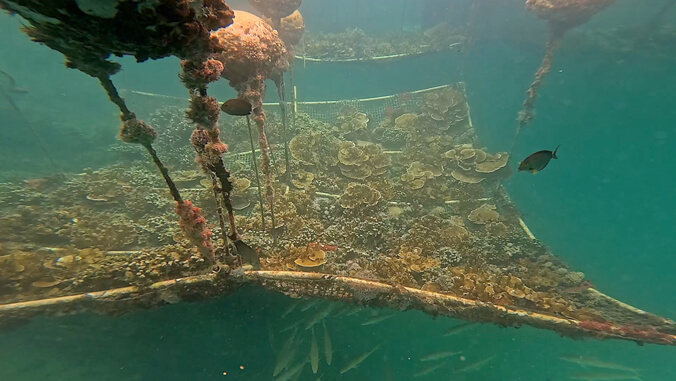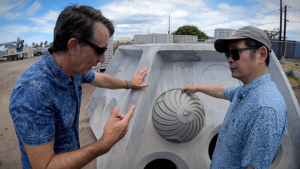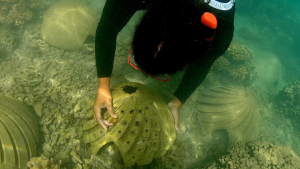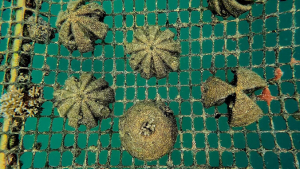
Breeding resilient corals.
UH developed, living coastal-protection system prepares for deployment
UH News September 2, 2024
The University of Hawaiʻi (UH) has reached a milestone in the U.S. Department of Defense funded project that aims to create a living breakwater system to protect coastlines from erosion and create ecosystems where resilient corals and other ocean life can grow and thrive.
The project, spearheaded by the Applied Research Laboratory at UH (ARL at UH) in partnership with UH Mānoa’s School of Ocean and Earth Science and Technology (SOEST), has completed the first concrete reef structure, and full production is now underway for 60 units. The project is on track for its first deployment of a 50-meter array of structures near the Ulupaʻu crater, off the Kailua Bay side of Marine Corps Base Hawaiʻi in late 2024, early 2025.

Concrete reef prototypes.
The Rapid Resilient Reefs for Coastal Defense (R3D) is a $27 million, five-year project funded by the Defense Advanced Research Projects Agency (DARPA) and is in partnership with University of California San Diego/Scripps Institution of Oceanography, Florida Atlantic University, Ohio State University and industry partner Makai Ocean Engineering located in Hawaiʻi.
“This project aims to redesign how we do coastal protection,” said Ben Jones, R3D principal investigator and ARL at UH Director of Ocean Science and Technology. “We’re looking at how to engineer a living breakwater system to protect coastlines and that will incorporate living coral. So we’ve engineered a coral reef that is inspired by natural fringing reefs.”
Concrete reef prototypes

Concrete reef prototypes with coral settlement module.
The two concrete reef prototypes, cast at Campbell Industrial Park, feature large holes to dissipate wave energy and are specifically designed to promote coral growth:
The Reef Crest structure (20 ft long x 8 ft wide x 7.7 ft high, 11.7 U.S. tons) will bear the brunt of the larger waves and will be anchored to the seabed to prevent it from moving during larger-wave events.
The Back Reef Structures (13.6 ft diameter x 5.2 ft tall x 4.4 US tons) will rest in calmer environments.
The structures will sit just below the water’s surface and leverage the natural shape of the seafloor to preserve the areas’ natural aesthetics.
“This is a really great project, a truly interdisciplinary project,” said Zhenhua Huang, SOEST Ocean and Resources Engineering professor. “I am a coastal engineer and through this project I am working with marine biologists, which is a totally different field. So, we work together to achieve this common goal, which is to come up with a solution that is nature based.”
Adaptive biology, nature-based solutions

Setting up coral settlement modules
One Hawaiʻi Institute of Marine Biology (HIMB) team has been breeding more resilient corals that are better at adjusting to warming oceans caused by climate change.
“The adaptive biology part of it is focused on how we get corals onto the structure that are going to survive marine heat waves and future climate change,” said Robert Toonen, HIMB research professor. “This project builds on over a decade of research at HIMB.”
A second HIMB team worked on the design and fabrication of coral settlement modules, complex habitat shapes, that will be placed on the concrete reef base structures. These structures will naturally recruit coral larvae. Additionally, thermally tolerant corals will be attached to some of the modules, which are designed to mimic natural coral reefs.
“We put out these structures with special crevices, cracks and crannies that we’ve noticed through multiple generations of design that coral babies love,” said Joshua Madin, HIMB research professor. “We kind of reverse engineered the reef to find out what they love about the reef and then we reproduced those using 3D printing and concrete casting methods and tested them.”

Design and fabrication of coral settlement modules.
Project’s next phase
After the team deploys the structures off of Marine Corps Base Hawaiʻi, the site will be monitored. Researchers say they will be able to measure the reduction in wave energy immediately, but it will take a few years to measure the success of the growth of the resilient corals and ecosystem.
“One of the most valuable aspects of this project is that we are taking all of the lessons that we are learning and developing a robust template for how to implement this work elsewhere,” said Joshua Levy, the project’s technical program manager. “This includes customizing surveying techniques and technology designs that best mimic the area’s physical environment and natural genetic diversity.”
The R3D team is also exploring potential applications at other vulnerable coastlines on Oʻahu such as Puʻuloa Range Training Facility in ʻEwa, and the Kaʻaʻawa coast.
Research that matters
R3D is one of many research projects at UH, which set a record in extramural funding awarded, with $615.7 million in fiscal year 2024. Extramural funding is investments from external agencies such as the federal government that support research conducted by university faculty and staff.
“This groundbreaking project is a prime example of how our world-class research is making a real impact in our communities,” said UH Vice President for Research and Innovation Vassilis L. Syrmos. “Addressing coastal erosion and creating more resilient coral reefs is research that matters to all of us here in Hawaʻi and to many around the world.”